Interchangeable Lens CameraOLYMPUS PEN E-PL9
Содержание
Features
- Art Filters and Advanced Photo mode
- In-body image stabilisation
- 4K movies
Olympus PEN E-PL9 specs
Sensor: 16.1MP Micro Four Thirds Live MOS
Lens mount: Micro Four Thirds
Screen: 3.0-inch tilting touchscreen, 1,040,000 dots
Burst shooting: 8.6fps
Autofocus: 121-point AF
Video: 4K
Connectivity: Wi-Fi and Bluetooth
Battery life: 350 shots
Weight: 380g
Olympus has designed the PEN E-PL9 so that it’s easy for novices to pick up but has a full range of manual controls and features for when you’re ready to start taking control.
In full Auto mode you can leave the camera to choose all the settings automatically and just use simple sliders on the touchscreen display to change the look of your pictures, with adjustments for color saturation, brightness, warmth, background blur and more. It side-steps the usual jargon of photography to show camera adjustments in less technical terms.
Alternatively, you can switch to the Scene position on the mode dial to tap on the subject you’re shooting, like People, Nightscapes or Motion, or use the PASM (program AE, aperture-priority, shutter-priority and manual) modes for direct control over the shutter speed and aperture settings.
Image 1 of 3
Image 2 of 3
Image 3 of 3
But Olympus adds in two more key features: Art Filters and its Advanced Photo mode. With new Bleach Bypass and Instant Film effects, there are now 16 different Art Filters, each with their own adjustable parameters. These go well beyond the sometimes cheesy and crude image effects seen on other cameras.
The Advanced Photo mode, meanwhile, includes features usually found on more advanced cameras, including Multiple Exposures, HDR, Sweep Panoramas and Focus Bracketing. They also include three Olympus specialities – a Keystone Compensation mode for correcting converging verticals in shots of buildings, a Live Composite mode for ‘light painting’ at night and a Live Time mode for watching long exposures build up ‘live’ on the rear screen.
It’s not all about stills photography, either, because the E-PL9 also offers some smart video features, including a standard video mode with the option of adding Art Filters and Movie Effects, a 4K video mode, a short Clips mode capturing 4 second videos (you can change the clip length) and an HS mode for slow motion playback.
The E-PL9 has a contrast-based autofocus system with 121 AF points covering most of the frame area, 3-axis in-body image stabilization (not the more advanced 5-axis system we’ve seen on other Olympus cameras) and maximum sensitivity of ISO 25,600.
It can also communicate directly with your smartphone via an always-on Bluetooth LE connection that can ‘wake’ your camera and Wi-Fi for full resolution image transfer and camera remote control.
The 10 best mirrorless cameras you can buy right now
Introduction
Olympus replaces its entry-level mirrorless camera, the PEN E-PL8, with the latest version, the Olympus PEN E-PL9.
The new camera is aimed at those looking to get a user-friendly interchangeable lens camera for the first time, especially smartphone users. However, this experienced reviewer found plenty to enjoy in the E-PL9.
Any Olympus micro-four-thirds camera is part of a system that has more than 20 proprietary lenses, as well as twice as many third-party lenses. There is something for all skill levels and budgets.
From the off we’ll say that the improvements in the E-PL9 are on the modest side of what was an already a solid (if expensive) entry-level mirrorless camera. Frankly, history has taught us to expect modest changes between versions. So, what is new?
Well, you get an improved set of video features. There is now 4K video recording up to 30fps (approx 100Mbps), with an option to extract still images from the video files. FHD videos are up to 60fps, whereas the E-PL8 is restricted to FHD up to 30fps. There is also 4k time-lapse plus slow motion videos up to 120fps, albeit at 720p resolution.
Video footage and still images can be stabilised with sensor-shift 3-axis stabilisation that provides up to 3.5EV compensation range. Of course, we’ll share our experiences in this review.
There is also the most recent imaging TRUE PIC VIII processor, as found in the latest round of Olympus cameras like the OM-D E-M1 Mark II.
Usually we’d hear about how a new processor improves JPEG handling and low light image quality. However, Olympus has been quiet on this front, so we expect a similar performance. We think this new processor primarily handles the improved video recording capabilities.
The contrast detection auto-focus system has been enhanced to a 121-AF-point array that covers a wider area of the frame. Focus points can be individually selected using the touch pad on the rear of the camera or by touching the LCD screen.
Otherwise, a built-in flash is now included, the camera grip is more pronounced, there is Bluetooth and Wi-Fi connections, plus a new interface which includes the thoroughly enjoyable AP mode (Advanced Photo).
The Olympus PEN E-PL9 is available now in three colours; white, black and brown. It costs £579.99 body only or £649.99 with the 14-42mm f/3.5-5.6 power zoom kit lens. That’s expensive for an entry-level CSC, but as you will find out in this review, the camera does offer a little more than most of its ‘competitors’.
Let’s now take a closer look around the camera.
Features
- Art Filters and Advanced Photo mode
- In-body image stabilisation
- 4K movies
Olympus PEN E-PL9 specs
Sensor: 16.1MP Micro Four Thirds Live MOS
Lens mount: Micro Four Thirds
Screen: 3.0-inch tilting touchscreen, 1,040,000 dots
Burst shooting: 8.6fps
Autofocus: 121-point AF
Video: 4K
Connectivity: Wi-Fi and Bluetooth
Battery life: 350 shots
Weight: 380g
Olympus has designed the PEN E-PL9 so that it’s easy for novices to pick up but has a full range of manual controls and features for when you’re ready to start taking control.
In full Auto mode you can leave the camera to choose all the settings automatically and just use simple sliders on the touchscreen display to change the look of your pictures, with adjustments for color saturation, brightness, warmth, background blur and more. It side-steps the usual jargon of photography to show camera adjustments in less technical terms.
Alternatively, you can switch to the Scene position on the mode dial to tap on the subject you’re shooting, like People, Nightscapes or Motion, or use the PASM (program AE, aperture-priority, shutter-priority and manual) modes for direct control over the shutter speed and aperture settings.
Image 1 of 3
Image 2 of 3
Image 3 of 3
But Olympus adds in two more key features: Art Filters and its Advanced Photo mode. With new Bleach Bypass and Instant Film effects, there are now 16 different Art Filters, each with their own adjustable parameters. These go well beyond the sometimes cheesy and crude image effects seen on other cameras.
The Advanced Photo mode, meanwhile, includes features usually found on more advanced cameras, including Multiple Exposures, HDR, Sweep Panoramas and Focus Bracketing. They also include three Olympus specialities – a Keystone Compensation mode for correcting converging verticals in shots of buildings, a Live Composite mode for ‘light painting’ at night and a Live Time mode for watching long exposures build up ‘live’ on the rear screen.
It’s not all about stills photography, either, because the E-PL9 also offers some smart video features, including a standard video mode with the option of adding Art Filters and Movie Effects, a 4K video mode, a short Clips mode capturing 4 second videos (you can change the clip length) and an HS mode for slow motion playback.
The E-PL9 has a contrast-based autofocus system with 121 AF points covering most of the frame area, 3-axis in-body image stabilization (not the more advanced 5-axis system we’ve seen on other Olympus cameras) and maximum sensitivity of ISO 25,600.
It can also communicate directly with your smartphone via an always-on Bluetooth LE connection that can ‘wake’ your camera and Wi-Fi for full resolution image transfer and camera remote control.
The 10 best mirrorless cameras you can buy right now
Form over function
If we could score a camera on looks alone, the E-PL9 would receive a 9.5 (we’ve got to save that extra 0.5 for the meticulously styled PEN-F). The physical changes over the E-PL8 are minimal, but the new angled grip gives it a slight ergonomic advantage. Paired with the impossibly small 14-42mm retractable kit lens, it’s a great looking piece of kit. Our review unit came wrapped in white faux leather, but brown and black are also available, along with a special edition blue that’s new to the E-PL9 and looks absolutely droolworthy in photos. Yes, we know, a pretty camera doesn’t mean it takes pretty pictures, but like it or not, this might help people take it out and use it more often, so that’s something.
Beneath the surface, Olympus says the body is built using “premium metal construction,” and while it certainly doesn’t feel bad, it doesn’t feel as well made as the likes of the PEN-F or the OM-D E-M5 or E-M1 series cameras. More importantly, it is not weather sealed, so while this is otherwise a fantastic travel camera, you will need to think twice before taking it out in the rain. (For the record, we decided to risk it by taking the camera into a river to photograph a waterfall, and it handled the mist just fine. We kept a safe distance, though.)
If we could score a camera on looks alone, the E-PL9 would receive a 9.5.
New to the E-PL9 is a built-in, pop-up flash. As always, on-camera flash should be used judiciously, but when you need it, it’s certainly more convenient to have it built-in than having to attach a small external unit, as was required for the E-PL8. More interesting, that flash also enables wireless flash control of up to three groups of remote flashes, a surprisingly high-end feature for an entry-level camera.
Of course, the E-PL cameras have always been about the casual shooter, and the E-PL9 is no different. The LCD screen is unchanged, measuring 3 inches and able to tilt just shy of 90 degrees up and a full 180-degrees down for low-angle shots and selfies, respectively. It is touch-sensitive, and responsiveness is quite good, even if it’s not immediately clear which onscreen elements can be accessed via touch and which require using the physical controls.
Daven Mathies/Digital Trends
There is a single command dial, and this is where things can get a bit confusing for experienced photographers. In program auto, shutter priority, or aperture priority, you can hit “up” on the four-way controller to toggle exposure compensation (in manual mode, this will switch from shutter speed to aperture control). However, if you are using the touchscreen to select an autofocus point (inarguably the easiest way to do so), this more-or-less locks you out from being able to toggle exposure compensation, as hitting “up” now simply moves the focus point. To get back to exposure comp (or aperture control), you first need to press “OK,” which then reverts the focus point you just selected on the touchscreen back to wherever it was before you touched the screen.
There are two ways around this. First, you can opt not to use the touchscreen to set a focus point, instead pressing “left” on the four-way pad to bring up the focus array and select your desired point with the directional buttons. When you then press “OK,” it will now lock in the selected AF point, rather than revert back to the default. Second — and this is our preferred method — you can dive into the settings menu to reassign exposure compensation to the function/magnifying glass button (located just behind the on/off button). Now you can access your exposure controls and touch autofocus together, but we wish it didn’t requiring jumping through hoops like that.
For more immediate results, you can also just turn on touch shutter, which will focus and take a picture with a single tap on the screen. This actually works quite well, although we prefer separating the focus and shutter actions, not to mention using the physical shutter button — call us old school, but it just feels better.
User experience
We spent two days camping with the PEN E-PL9 in the lush wilderness of Washington’s Gifford Pinchot National Forest. Minus the lack of dust- and splash-proofing, it’s the perfect camera for day hikes, riverside gatherings, and campfire cooking. You can toss it in jacket pocket, purse, or other small bag and it’s light enough that you’ll barely know it’s there. Battery life is rated for 350 exposures, which is low enough to be considered “bad,” but it was still plenty for our excursion.
This is the camera you want to recommend to your friend looking to boost the quality of their Instagram feed — but will they actually use it?
There is one other advantage of using a camera like this: It helps you blend in, even when you’re just trying to blend in with your own friends. You can easily shoot from the hip, and when you’re not holding a camera in front of your face, you feel much more a part of the action and other people act more naturally around you. It’s great for street photography, particularly with the compact lens.
But, while we were setting up at the base of a waterfall with tripod and neutral density filters in hand, we encountered a depressing reminder of the futility of our efforts when a group of three young people showed up and began posing for each other for what we can only assume was a very important Instagram photoshoot. They spent no less than 45 minutes trying to get the perfect pose, angle, and moment in front of the rushing waterfall — and the entire time used nothing but their phones. This went far beyond “casual” photography, yet apparently a phone was just fine.
Daven Mathies/Digital Trends
And that’s the thing: No matter how much more technically proficient a camera like the E-PL9 is, and no matter the effects of a long shutter, shallow depth of field, or other creative advantages it offers, it won’t make your butt look better, your muscles bigger, or your experience any more real. If those are the things that matter in your photography, then you really don’t need a dedicated camera. (And we get it, phone cameras are really good now.)
But those with at least a passing interest in actually learning photography owe it to themselves to invest in an interchangeable lens camera, and the E-PL9 seems like the perfect introductory model — at least, at first. The issue here is that it doesn’t leave much room to grow into. This is a camera designed to be shot in automatic mode, and while some people will undoubtedly appreciate that, those are the same people likely to just stick with their phones.
Of course, you can’t escape the phone completely. Like nearly all cameras today, the E-PL9 can pair with a phone to upload shots to social media. Perhaps that isn’t convenient, but at least your Instagram shots will look great.
Результаты тестирования Olympus Pen E-PL9
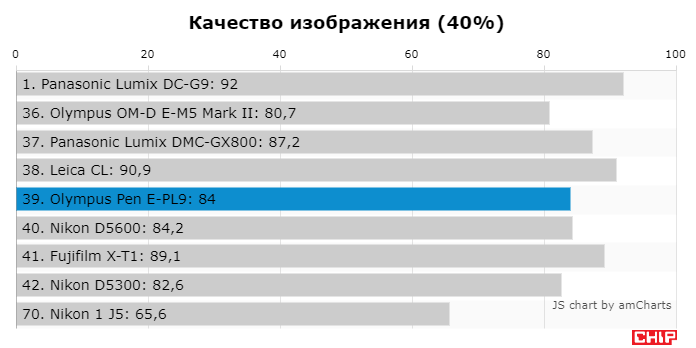
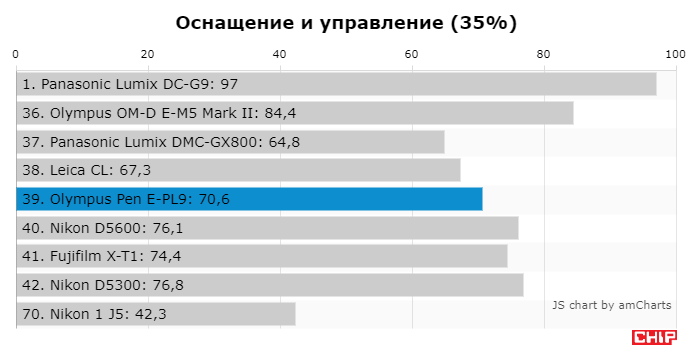
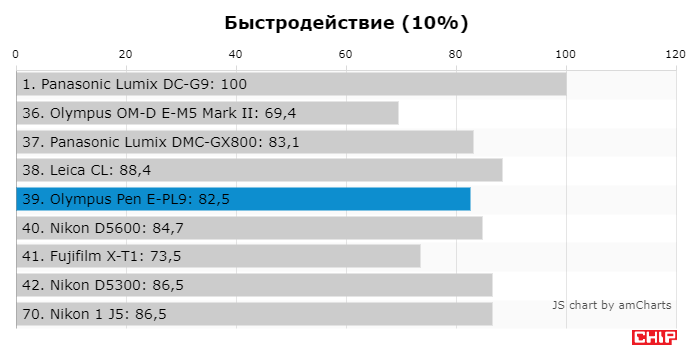
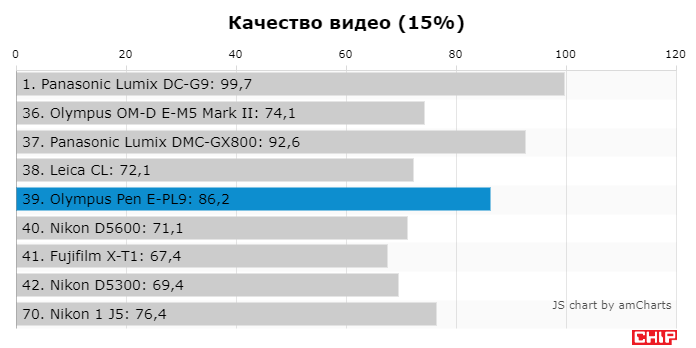
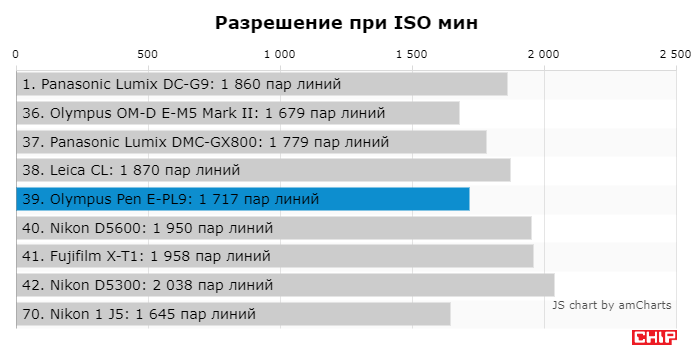

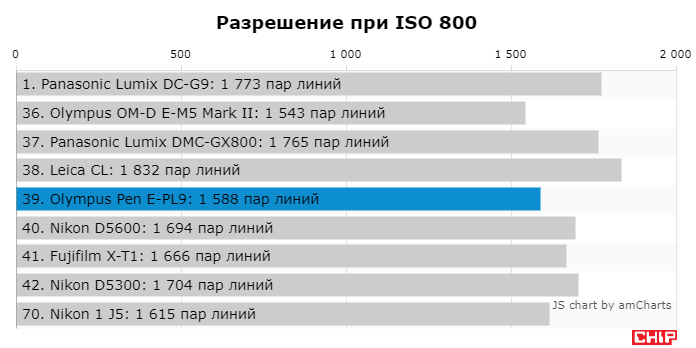
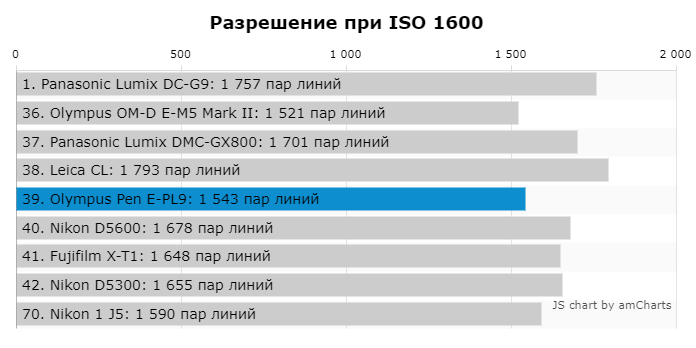
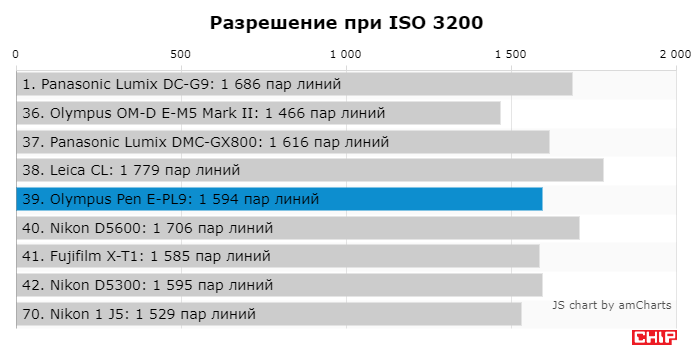

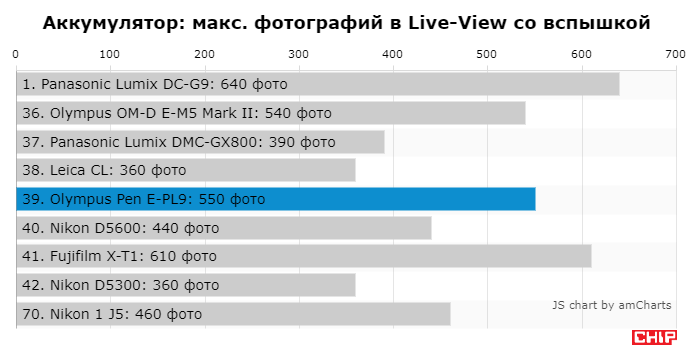

Характеристики и результаты тестирования Olympus Pen E-PL9
| Соотношение цена/качество |
|
| Тип камеры | |
| Эффективное количество пикселей | |
| Максимальное разрешение фото | |
| Тип сенсора | |
| Размеры сенсора | |
| Очистка сенсора | |
| Встроенный стабилизатор (в камеру) | |
| Запись видео | |
| Крепление объектива | |
| Объектив при оценке качества снимков | |
| Объектив при оценке быстродействия | |
| Минимальное время спуска затвора | |
| Максимальное время спуска затвора | |
| Видоискатель | |
| Покрытие видоискателя | |
| Увеличение видоискателя | |
| Дисплей: диагональ | |
| Дисплей: разрешение | |
| Дисплей: тачскрин | |
| Дисплей: запуск записи видео с тачскрина | |
| Дисплей: возможность поворота | |
| Дисплей: селфи-режим | |
| Второй дисплей | |
| Датчик ориентации | |
| GPS | |
| Минимальное ISO | |
| Максимальное ISO | |
| Мин. время синхронизации со вспышкой | |
| Баланс белого (кол-во предустановок) | |
| Баланс белого: по шкале Кельвина | |
| Разрешение при ISO мин | |
| Разрешение при ISO 400 | |
| Разрешение при ISO 800 | |
| Разрешение при ISO 1600 | |
| Разрешение при ISO 3200 | |
| Разрешение при ISO 6400 | |
| Детализация при ISO мин | |
| Детализация при ISO 400 | |
| Детализация при ISO 800 | |
| Детализация при ISO 1600 | |
| Детализация при ISO 3200 | |
| Детализация при ISO 6400 | |
| Визуальный шум при ISO мин | |
| Визуальный шум при ISO 400 | |
| Визуальный шум при ISO 800 | |
| Визуальный шум при ISO 1600 | |
| Визуальный шум при ISO 3200 | |
| Визуальный шум при ISO 6400 | |
| Экспертная оценка: шумность и детализация при ISO мин | |
| Экспертная оценка: шумность и детализация при ISO 1600 | |
| Экспертная оценка: шумность и детализация при ISO 3200 | |
| Экспертная оценка: шумность и детализация при ISO 6400 | |
| Время готовности к съемке из выключенного состояния | |
| Время задержки спуска затвора при ручной фокусировке | |
| Время задержки спуска затвора с автофокусом при дневном свете | |
| Время задержки спуска затвора с автофокусом при слабом освещении | |
| Время задержки спуска затвора в режиме Live-View с автофокусом при дневном свете | |
| Скорость серийной съемки в RAW | |
| Длина серии в RAW | |
| Скорость серийной съемки в JPEG | |
| Длина серии в JPEG | |
| Аккумулятор | |
| Стоимость аккумулятора | |
| Аккумулятор: макс. фотографий со вспышкой | |
| Аккумулятор: макс. фотографий без вспышки | |
| Аккумулятор: макс. фотографий в Live-View со вспышкой | |
| Аккумулятор: макс. фотографий в Live-View без вспышки | |
| Аккумулятор: продолжительность записи видео | |
| Разъем для микрофона | |
| Встроенная вспышка | |
| Управление вспышкой | |
| Дистанционный спуск затвора | |
| Тип карты памяти | |
| WLAN | |
| NFC | |
| Материал корпуса | |
| Корпус: защита от пыли и водяных брызг | |
| Габариты | |
| Вес без объктива |
